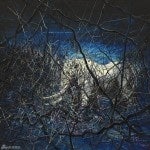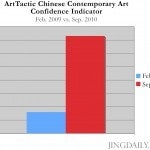Our 10 Favorite Art Posts Of 2010#

BMW Commissions Jeff Koons For 2010 Art Car: Will A Chinese Artist Be Next? (February 5)
The BMW art car program, as one of the most high-profile and established business/art programs, is an annual opportunity for the brand to engage in unique cultural realms and reach new audiences. Following BMW’s announcement that Koons would be this year’s artist, the Jing Daily editorial team discussed the question of whether a Chinese artist could be included among the ranks of “art car artists” in the near future.
There are several reasons why we think a Chinese artist would benefit the art car program, but a few of them in particular stand out: One, aside from Japanese artist Matazo Kayama (1990), no Asian artists have been included in the program; Two, BMW is enjoying unprecedented (and still growing) popularity in the mainland Chinese auto market (which, as of last year, has become the largest auto market in the world and is unlikely to lose that distinction for years to come); and Three, the status of top Chinese contemporary artists has risen immensely over the past three decades, putting them on par with their peers elsewhere.

Jing Daily Exclusive Interview With Filmmaker Jia Zhangke (Part 1 / Part 2) (March 17 / March 24)
Last week, the Jing Daily team had the opportunity to interview Jia Zhangke (Platform, Still Life, 24 City), one of China’s top contemporary filmmakers, at the Museum of Modern Art (MoMA) in New York during its retrospective of Jia’s work. Conducted in Mandarin, our 30-minute interview covered a range of important topics in the world of Chinese cinema, and shed light on Jia Zhangke’s opinions about everything from the current state of the official Chinese film system to the importance of nurturing young talent to the key developments in today’s China that inspire him as a filmmaker.
In Part One of our two-part interview, Jia discusses the key developments in film production in China, his personal experiences as a young director in Beijing in the mid-’90s and support of young directors there today, and the difference between being an “underground” director and one who operates within China’s state film system. Next Wednesday (March 24), we will post Part Two, in which Jia discusses his film production company, XStream, and some of the upcoming projects he is currently involved in — both as a director and producer.

Blue-Chip Chinese Artists Crush Estimates In Hong Kong (April 5)
Results only came in a few hours ago, but from our first look at the numbers from the Sotheby’s spring auction of Contemporary Asian Art in Hong Kong, it’s safe to say that Chinese and other Asian collectors were in the mood to buy today. Much like what we saw this weekend with the first auction of this wide-ranging Sotheby’s series — the fifth installment of the “Classic Cellar From a Great American Collector” wine series — which brought in HK$49.7 million (US$6.4 million), the mainly Chinese collectors at the Contemporary Asian Art auction weren’t afraid to go far beyond high estimates for high-quality pieces by some of China’s top blue-chip artists.
Perhaps not surprisingly, Chinese collectors fought hard for works by artists who are rising in popularity in mainland China, such as Liu Ye, Cai Guo-Qiang, and Yue Minjun. However, other blue-chip Chinese artists, such as Wang Guangyi, Ai Weiwei, Zeng Fanzhi and Yan Pei-Ming proved extremely popular as well, with Wang’s “Passport (set of 30)” selling for US$1.08 million — the first time a piece by Wang has topped $1 million since 2007.

Zeng Fanzhi Painting Sets Record At BAZAAR Charity Auction In Shanghai (April 26)
Last night, BAZAAR China held its 8th annual Charity Night event in Shanghai, which raised a total of 19 million RMB (US$2.75 million) for the China Social Assistance Foundation (CSAF). The money raised at the event will be put towards the reconstruction of Yushu, the site of this month’s devastating earthquake, as well as drought relief in the stricken southwestern provinces of Guizhou, Guangxi and Yunnan. In attendance at last night’s event were more than 400 celebrities and businesspeople, including international stars like Halle Berry and the South Korean pop group Wonder Girls.
At the night’s charity auction, in addition to watches and jewelry from companies such as Tiffany, Cartier and Chow Tai Fook, up for grabs was a new painting by top Chinese contemporary artist Zeng Fanzhi, “Untitled 10-3-23.” The 200 x 200 cm oil painting sold for a whopping 10 million RMB (US$1.5 million) to an unnamed bidder after a contentious bidding battle with the actor Huang Xiaoming.

Exhibition Review: Cai Guo-Qiang – “Peasant Da Vincis” (May 6)
In March, Jing Daily translated an Artron article (Chinese) about the new exhibition being prepared by Cai Guo-Qiang, one of China’s most celebrated contemporary artists, for the restored Rockbund Art Museum. (a 1930s-era Art Deco building that formerly housed the Royal Asiatic Society.) As we wrote at that time, the new exhibition planned by Cai, “Peasant da Vincis” (农民达芬奇), would populate the impressive exhibition space at Rockbund with the homemade creations of nine rural Chinese inventors, including a helicopter, a submarine, and a selection of robots.
On May 4, “Peasant da Vincis” opened to the public, just in time for the Shanghai World Expo, and there’s been plenty of coverage this week in the English-language press, noting the contrast between the amateur, DIY spirit of the work of these “Peasant da Vincis” and the polished, corporate image of the World Expo.

Why Beijing Dominates China’s Art Auction Market (July 8)
The Chinese art market has seen a healthy rebound over the past six to nine months, as mainland-based collectors have pushed prices for traditional artwork to record-breaking highs and prices for blue-chip contemporary artists approaching pre-financial-crisis levels. However, this rebound has really only been seen in Beijing and Hong Kong, as Shanghai — despite massive investment in the city’s cultural and arts infrastructure — has yet to build an auction market that can compete. But why is this? Shanghai certainly isn’t hurting for cash, and the city is home to some of mainland China’s top art collectors and thousands of millionaires looking to get in on the game.
According to an article this week in Shanghai Daily, the contrast between the Beijing and Shanghai auction markets is “striking – and embarrassing,” and helps to illustrate why, despite having China’s first auction house (Duo Yun Xuan, est. 1992), Shanghai lags far behind its northern neighbor.

Private Museum Summit Held In Beijing To Discuss Regulation (August 4)
An interesting development in the Chinese art world over the past several years has been the rapid growth of private collection (which we’ve covered extensively) and the creation of private museums by some contemporary or traditional art “super-collectors.” From Guan Yi’s contemporary art “warehouse” to the mixed contemporary/revolutionary art museum planned by Wang Wei and Liu Yiqian, many of China’s top collectors have some plan or another to open their own museums.
However, the Chinese government’s lack of clarity regarding the establishment and regulation of private museums has caused a great deal of confusion among some in the Chinese museum world. In the hopes of clearing up this confusion, the “Private Museum Summit” was recently held in Beijing.

ArtTactic’s Chinese Contemporary Art Market Confidence Survey Shows Continued Strong Recovery (September 2)
This week, ArtTactic released its newest Chinese contemporary art market confidence survey, which — as expected, considering the success of this spring’s auctions in Hong Kong and mainland China — shows a 27% positive increase in confidence over December 2009, with a majority of respondents believing either that the Chinese contemporary art market has rebounded or will do so within one year.
Over the past 18 months, the emergence of the mainland Chinese auction house as a strong regional force and the growing clout of new Chinese collectors has injected a serious dose of optimism into the market, and led ArtTactic to conclude that the current trend sets out the possibility that Chinese contemporary art volume in 2010 might even come close to pre-crisis historical levels.

Artwork By Yue Minjun, Qi Zhilong To Appear In Chinese Drama “Color Me Love” (September 28)
On October 28, works by two of China’s top contemporary artists, Yue Minjun and Qi Zhilong, will get major nationwide exposure, appearing in several scenes in the romantic drama “Color Me Love” (爱出色). Directed by Alexi Tan (Blood Brothers, Double Blade) and starring Liu Ye (not to be confused with the artist Liu Ye), Yao Chen and Joan Chen, “Color Me Love” tells the love story of a fashion editor, Wang Xiaofei (played by Yao) and her hot-shot artist boyfriend, Luan Yihong (Liu), as the two do their best to stay together amid the challenges of navigating Beijing’s art and fashion circles. Joan Chen, in a role fashioned after Meryl Streep’s character in “The Devil Wears Prada,” plays Wang’s overbearing boss.
As Artron (Chinese) points out this week, rather than using artwork as glorified set dressing, director Alexi Tan said he hopes to actually work the paintings into the film’s narrative.

Ai Weiwei: From Art Star To Asteroid (December 20)
Following his recent show at the São Paulo Biennale, the opening of his “Sunflower Seeds” installation at the Tate Turbine Hall in London, and his temporary house arrest in Beijing, of all places it looks like artist Ai Weiwei’s name will show up next in outer space. According to a Ming Pao article (Chinese), Hong Kong-born Canadian astronomer Yang Guangyu (Bill Yeung) has “successfully applied” to have asteroid 83598 renamed “Ai Weiwei Star” (艾未未星). Yang was quick to tell the media that his decision to “devote the star” (献星) to Ai Weiwei was due to Ai’s artistic contributions, rather than his human rights campaigning, saying he chose Ai “simply because he deserves praise for designing the Bird’s Nest [in Beijing]. It has nothing to do with politics” (”纯因他设计北京鸟巢值得表扬,与政治无关”).
Upon hearing the news of Yang’s plans, Ming Pao quoted Ai Weiwei as saying, “Oh really? How interesting!” Ai was also quoted as joking that the renaming of the asteroid would enable him to “illuminate” different places around the world.